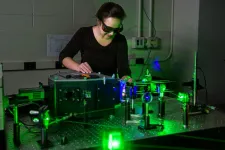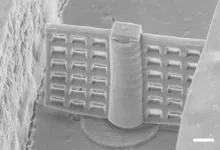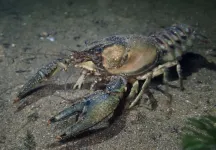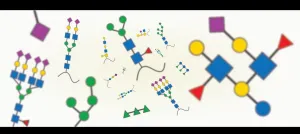The electron merry-go-round
2021-06-15
(Press-News.org) Photoemission is a property of metals and other materials that emit electrons when struck by light. Electron emission after light absorption was already explained by Albert Einstein. But since this effect is a highly complex process, scientists have still not been able to fully elucidate its details. Prof. Dr. Bernd von Issendorff and his team at the University of Freiburg's Institute of Physics have now succeeded in detecting a previously unknown quantum effect in the angular distributions of photoelectrons from cryogenic mass-selected metal clusters. The angular distributions resemble those of classical particles, a behavior that is surprisingly explainable by the strong electron-electron interaction in these many-electron systems. The researchers published this finding in the current issue of Physical Review Letters.
Electrons with well-defined angular momenta
Metal clusters may be seen as quantum systems consisting of a countable amount of quantum particles - in this case electrons - in a simple spherical box potential. Electrons in simple metal clusters possess relatively well-defined angular momenta, although a cluster is never perfectly round. This is due to the virtually optimal shielding of the atomic nuclei by the electron system. Hence, a single electron experiences only an average interaction that is remarkably close to the interaction with a spherical box potential. As a consequence, the electrons practically assume angular momentum eigenstates, i.e., rotate with a well-defined angular momentum. Moreover, the photoemission of the electron occurs only at the cluster surface, because only there can the required radial momentum be transferred to the electron.
Electron emission occurs only at the surface
Researchers expected that the electron's momentum would be preserved parallel to the surface during photoemission, as there are no forces acting in this direction. "Since an electron with a defined angular momentum at the surface has a defined momentum parallel to it, it could be assumed," explains von Issendorff, "that the angular distribution of the electrons corresponds to that of balls simply released by children from a rotating merry-go-round. They do not fly radially outward but tangentially to the circular path." The Freiburg researchers observed just this effect on metal clusters, thus verifying that the electrons indeed can be seen as particles rotating in a box potential and that the electron emission actually does occur only at the surface. The surprise, however, says von Issendorff, is that this observation is completely contradictory to quantum mechanical simulations, which always predict a much more complex behavior dominated by inferences and resonances in the ionization process.
Mathematical description of the angular functions
However, the Freiburg researchers were able to resolve this contradiction: On the basis of their earlier work and in discussions with researchers at the Max Planck Institute for the Physics of Complex Systems in Dresden, they derived a complete mathematical description of the angular functions that corresponds very well to the experiment. The core assumption of this new description is that the cluster is completely non-transparent for electrons: Electrons are strongly decelerated inside the cluster. This leads to a suppression of the interference and resonance effects and thus to an almost classical behavior. It was already known that decoherence suppresses interferences. What is new, however, is that the strong dissipation does not lead to a complete washout of the angular distributions of the electrons but, on the contrary, produces very structured and almost classical distributions.
Behavior like a classical particle
"We're used to quantum effects predominating at small scales, whereas a classical description is often a good approximation for effects at larger scales," explains von Issendorff. "Here, classical behavior arises even at a small scale through dissipation. The complicated interplay between a multitude of electrons results in one of these electrons behaving like a classical particle."
INFORMATION:
Original publication:
Piechaczek, A., Bartels, C., Hock, C., Rost, J.-M., von Issendorff, B. (2021): Decoherence-induced universality in simple metal cluster photoelectron angular distributions. In: Physical Review Letters, 126, 233201 (2021). DOI: 10.1103/PhysRevLett.126.233201
[Attachments] See images for this press release:
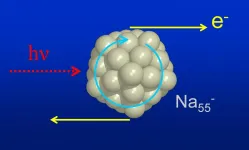
ELSE PRESS RELEASES FROM THIS DATE:
2021-06-15
Washington, D.C. - June 15, 2021 - Viral genome sequencing of wastewater can provide an early warning system of emerging SARS-CoV-2 variants that is independent of investigations of identified clinical cases, according to a new study published in mSystems, an open-access journal of the American Society for Microbiology. In the study, researchers describe the detection and quantification of variant B.1.1.7, first identified in southeast England, in sewage samples from London, United Kingdom before widespread transmission of this variant was obvious from clinical cases.
"Wastewater sampling and environmental surveillance ...
2021-06-15
Humans can do lots of things that plants can't do. We can walk around, we can talk, we can hear and see and touch. But plants have one major advantage over humans: They can make energy directly from the sun.
That process of turning sunlight directly into usable energy - called photosynthesis - may soon be a feat humans are able to mimic to harness the sun's energy for clean, storable, efficient fuel. If so, it could open a whole new frontier of clean energy. Enough energy hits the earth in the form of sunlight in one hour to meet all human civilization's energy needs for an entire year.
Yulia Puskhar, a biophysicist and professor of physics in Purdue's College of Science, may have a way to harness that energy by mimicking plants.
Wind ...
2021-06-15
Proper chromosome segregation into two future daughter cells requires the mitotic spindle to elongate in anaphase. However, although some candidate proteins are implicated in this process, the molecular mechanism that drives spindle elongation in human cells has been unknown, until now! Researchers at the Croatian Ruđer Bošković Institute (RBI) have discovered the exact molecular mechanism of bridging microtubules sliding and its role in proper distribution of genetic material during cell division. These latest results were published in the scientific journal Developmental Cell (IF: 10.092).
Cell division is a fundamental process required for stable transmission ...
2021-06-15
WASHINGTON -- Researchers have fabricated a magnetically driven rotary microfilter that can be used to filter particles inside a microfluidic device. They made the tiny turning filter by creating a magnetic material that could be used with a very precise 3D printing technique known as two-photon polymerization.
Microfluidic devices, also known as lab-on-a-chip devices, can be used to perform multiple laboratory functions inside a chip that usually measures a few square centimeters or less. These devices contain intricate networks of microfluidic channels and are becoming more and more complex. They may be useful for a variety of applications such as screening molecules ...
2021-06-15
Antidepressants can help humans emerge from the darkness of depression. Expose crayfish to antidepressants, and they too become more outgoing -- but that might not be such a positive thing for these freshwater crustaceans, according to a new study led by scientists with the University of Florida.
"Low levels of antidepressants are found in many water bodies," said A.J. Reisinger, lead author of the study and an assistant professor in the UF/IFAS soil and water sciences department. "Because they live in the water, animals like crayfish are regularly exposed to trace amounts of these ...
2021-06-15
Pharmaceutical pollution is found in streams and rivers globally, but little is known about its effects on animals and ecosystems. A new study, published in the journal Ecosphere, investigated the effects of antidepressant pollution on crayfish. Just two weeks of citalopram exposure caused changes in crayfish behavior, with the potential to disrupt stream ecosystem processes like nutrient cycling, oxygen levels, and algal growth.
Coauthor Emma Rosi, a freshwater ecologist at Cary Institute of Ecosystem Studies, says, "Animals living in streams and rivers are exposed to a chronic mix of pharmaceutical pollution as a result of wastewater contamination. Our study explored how antidepressant levels ...
2021-06-15
New Haven, Conn. --In a new study led by Yale Cancer Center, researchers show the nucleoside transporter ENT2 may offer an unexpected path to circumventing the blood-brain barrier (BBB) and enabling targeted treatment of brain tumors with a cell-penetrating anti-DNA autoantibody. The study was published today online in the Journal of Clinical Investigation Insight.
"These findings are very encouraging as the BBB prevents most antibodies from penetrating the central nervous system and limits conventional antibody-based approaches to brain tumors," said James E. Hansen, MD, associate professor of therapeutic radiology, radiation oncology chief of the Yale Gamma Knife Center at Smilow Cancer Hospital, and corresponding author of the study.
Deoxymab-1 (DX1) ...
2021-06-15
Ethiopia, Nigeria, Colombia, Myanmar and Syria are just a handful of the places around the world currently engaged in ongoing civil wars. Even when peace agreements can be negotiated to end civil wars, maintaining stability is incredibly challenging. In these fragile post-conflict areas, a small communal dispute can easily escalate and unravel peace deals.
Peacekeepers can help contain the spread of violence and promote peaceful interactions between groups, but how? And in what situations can peacekeepers be most effective? New research from Washington University ...
2021-06-15
Changing your eating habits or altering your circadian clock can impact healthy fat tissue throughout your lifespan, according to a preclinical study published today in Nature by researchers with The University of Texas Health Science Center at Houston (UTHealth).
Healthy fat tissue helps provide energy, supports cell growth, protects organs, and keeps the body warm. A good quality diet and one that is consumed in a rhythmic manner (i.e., during our active cycle) is important in maintaining healthy fat, the researchers found.
Adipocyte progenitor cells mature into adipocytes - the healthy fat cells that make up our adipose tissue, which stores energy as fat. Researchers discovered that adipocyte progenitors undergo rhythmic daily proliferation throughout the ...
2021-06-15
A new model that applies artificial intelligence to carbohydrates improves the understanding of the infection process and could help predict which viruses are likely to spread from animals to humans. This is reported in a recent study led by researchers at the University of Gothenburg.
Carbohydrates participate in nearly all biological processes - yet they are still not well understood. Referred to as glycans, these carbohydrates are crucial to making our body work the way it is supposed to. However, with a frightening frequency, they are also ...
LAST 30 PRESS RELEASES:
[Press-News.org] The electron merry-go-round

